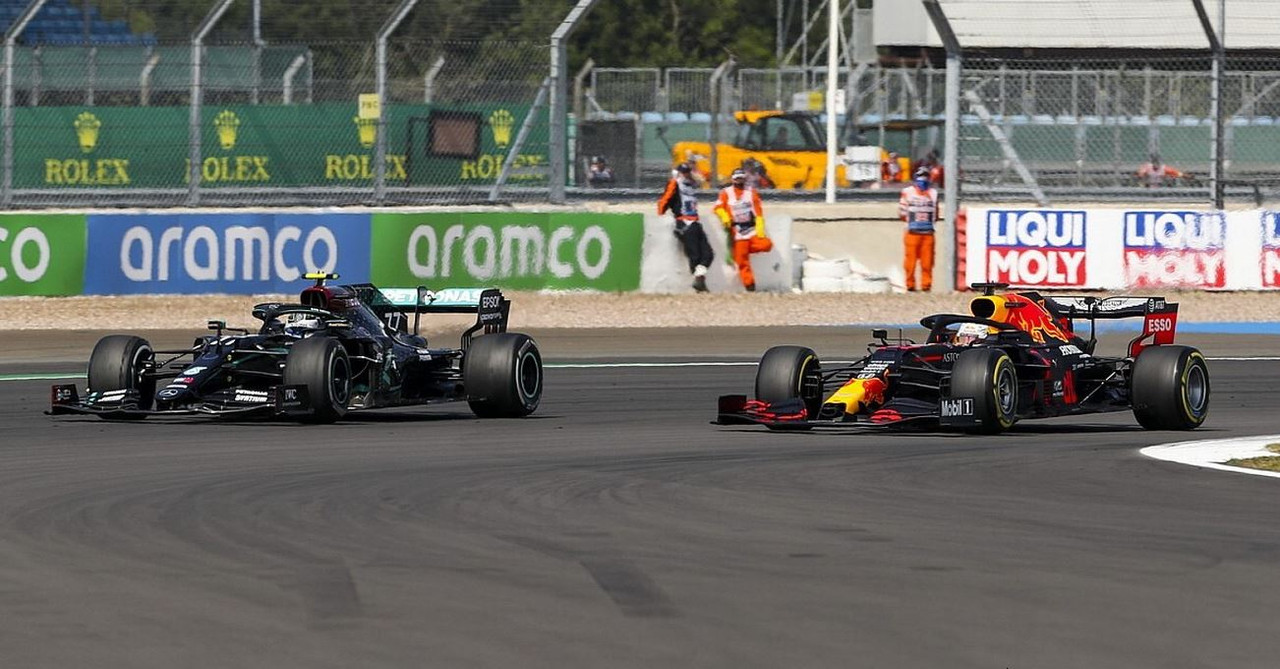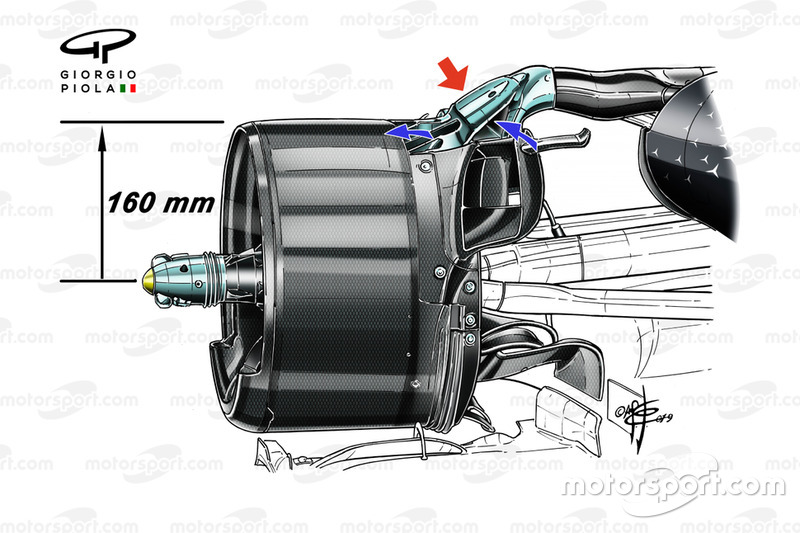FabreDAS
- Login or Register
No account yet? Sign up

Mercedes didn’t have issues eating tires in 2014 at some races they had issues putting heat into them and were off the pace (Singapore)
correct, Merc's tire eating days where 2012 and to a much lesser extent 2013.holeindalip wrote: ↑10 Aug 2020, 18:40Mercedes didn’t have issues eating tires in 2014 at some races they had issues putting heat into them and were off the pace (Singapore)
Thanks for posting that! I was looking for that in case anyone wanted some corroboration.
I went hunting after I saw your post.zibby43 wrote: ↑10 Aug 2020, 20:22Thanks for posting that! I was looking for that in case anyone wanted some corroboration.



I heard they are working on two things: 1. reconfigure the air feeds inside the rear wheel hubs in order to cool down overheated rear tyres and 2. increase the heat sink capacity at the rear wheel rim.zibby43 wrote: ↑10 Aug 2020, 08:34The technical explanation/setup change that caused the tire issues:
"Mercedes went into this race more concerned than the outside world might have imagined, given how comfortably it had locked out the front row, Bottas ahead of Hamilton this time.
Its concern was always tyre behaviour in the very high temperatures forecasted for race day. It had struggled in such conditions in the Friday practices of the Styrian and British GP weekends. But this time it had looked very strong in the high temperature race runs of Friday afternoon.
Yes, but the Mercedes were eating through the left-front. So their set-up into Friday sought to protect that tyre – and in so doing transferred more of the load onto the rears. Turns out, there just wasn’t the capacity there for the rears to accept that increased burden."
https://the-race.com/formula-1/the-merc ... defeat-it/
Now, how to solve the problem of making sure the W11 isn't getting blisters on either the front or rear tires is the engineering challenge that the team is going to have to make progress on before Sunday in Barcelona. The re-appearance of the C1 will surely help Mercedes a bit, but they can't always rely on optimum temperatures or the hardest compounds.
Very interesting stuff! Makes perfect sense too, as Merc did have to reconfigure some of the rear brake duct and rear suspension hardware after Red Bull complained in Barcelona testing.atanatizante wrote: ↑12 Aug 2020, 08:51I heard they are working on two things: 1. reconfigure the air feeds inside the rear wheel hubs in order to cool down overheated rear tyres and 2. increase the heat sink capacity at the rear wheel rim.zibby43 wrote: ↑10 Aug 2020, 08:34The technical explanation/setup change that caused the tire issues:
"Mercedes went into this race more concerned than the outside world might have imagined, given how comfortably it had locked out the front row, Bottas ahead of Hamilton this time.
Its concern was always tyre behaviour in the very high temperatures forecasted for race day. It had struggled in such conditions in the Friday practices of the Styrian and British GP weekends. But this time it had looked very strong in the high temperature race runs of Friday afternoon.
Yes, but the Mercedes were eating through the left-front. So their set-up into Friday sought to protect that tyre – and in so doing transferred more of the load onto the rears. Turns out, there just wasn’t the capacity there for the rears to accept that increased burden."
https://the-race.com/formula-1/the-merc ... defeat-it/
Now, how to solve the problem of making sure the W11 isn't getting blisters on either the front or rear tires is the engineering challenge that the team is going to have to make progress on before Sunday in Barcelona. The re-appearance of the C1 will surely help Mercedes a bit, but they can't always rely on optimum temperatures or the hardest compounds.
They don't have much room to play regarding rear suspension setup due to their low rake stiff suspension philosophy as I explained at the above post... My two cents

They can rip a bit of downforce off, as their competitors are miles behind and avoid putting so much load in tyres and still be ahead! Induce a bit of understeer and go slightly slower through the corners, but it would allow them a bit more straight line speed, which they would anyway do in Spa and Monza. That is much more easier to do, while they build better solution to better manage the tyres with their full downforce package, if the speculation of that article is indeed true. I have stopped believing some of these hollywood paparazzi guys, masquerading as F1 journalists, long ago.zibby43 wrote: ↑12 Aug 2020, 08:58Very interesting stuff! Makes perfect sense too, as Merc did have to reconfigure some of the rear brake duct and rear suspension hardware after Red Bull complained in Barcelona testing.atanatizante wrote: ↑12 Aug 2020, 08:51I heard they are working on two things: 1. reconfigure the air feeds inside the rear wheel hubs in order to cool down overheated rear tyres and 2. increase the heat sink capacity at the rear wheel rim.zibby43 wrote: ↑10 Aug 2020, 08:34The technical explanation/setup change that caused the tire issues:
"Mercedes went into this race more concerned than the outside world might have imagined, given how comfortably it had locked out the front row, Bottas ahead of Hamilton this time.
Its concern was always tyre behaviour in the very high temperatures forecasted for race day. It had struggled in such conditions in the Friday practices of the Styrian and British GP weekends. But this time it had looked very strong in the high temperature race runs of Friday afternoon.
Yes, but the Mercedes were eating through the left-front. So their set-up into Friday sought to protect that tyre – and in so doing transferred more of the load onto the rears. Turns out, there just wasn’t the capacity there for the rears to accept that increased burden."
https://the-race.com/formula-1/the-merc ... defeat-it/
Now, how to solve the problem of making sure the W11 isn't getting blisters on either the front or rear tires is the engineering challenge that the team is going to have to make progress on before Sunday in Barcelona. The re-appearance of the C1 will surely help Mercedes a bit, but they can't always rely on optimum temperatures or the hardest compounds.
They don't have much room to play regarding rear suspension setup due to their low rake stiff suspension philosophy as I explained at the above post... My two cents
https://cdn-4.motorsport.com/images/mgl ... duct-1.jpg
The rear brake duct and suspension upright on the W11 initially featured a design that utilized the suspension upright to create an extra inlet above the main brake duct. That fed airflow into a cavity on the top of the brake duct, which helped cooling/tire management.
Do you have an inside source for your info., or did your read that somewhere?

Regarding their low rake philosophy I think is old stuff by now ... then, what they are working on comes out from blogger speculation in my country ... the last update says they don`t have enough time to alter the channel inside the wheel hub and instead they`ll increase the rear brake duct area which will lead to increase turbulence & drag with a negative impact of the air above the diffuser hence a small decrease in DF levels ... those 2 solutions his best bet is they were short to medium time projects ...